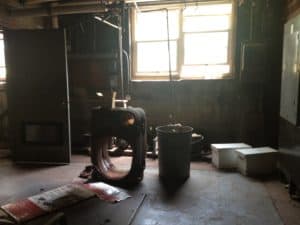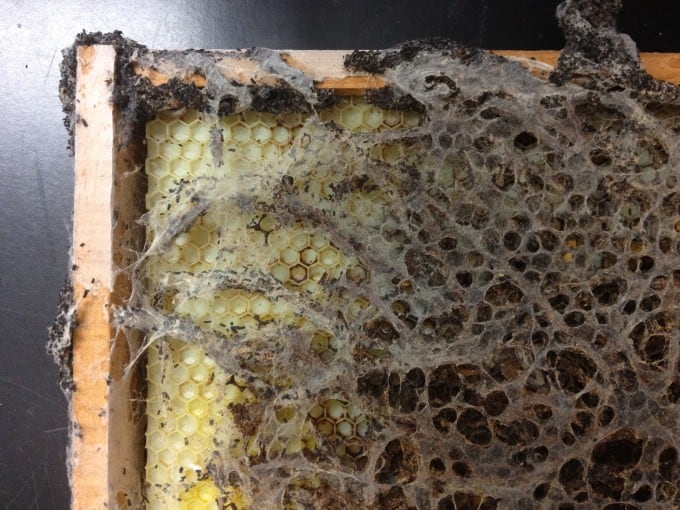One of this summer’s projects involves documenting a frame that is succumbing to a wax moth infestation. As I am finding out, through this documentation, wax moths are a highly destructive moth that attack honey bee frames, chewing their way through comb and wood and devastating an already weak colony. The damage is rapid, dirty, and I can’t lie, it is thoroughly grossing me out.

The pesky moth has four larval stages, beginning as an egg. A female wax moth can produce up to 300 eggs and while not all will hatch, it is easy to see how a wax moth issue can quickly grow out of hand. Clothed in darkness, females typically lay their eggs at night, vanishing before daylight, but leaving brood evidence of destruction in their wake. After the eggs hatch and move into the larval stage, and in my opinion, as grotesque, plump, soft bodied gray worms, about ¾ of an inch long, they burrow into the comb creating a series of tunnels underneath cappings and weave a series of sticky white webs. The larvae stay at this stage for about 3 weeks to 3 months depending on the temperature (the hotter the faster the infestation occurs) and then transition to their adult stage by way of a tough, silk cocoon.

Creepy USDA boiler room AKA wax moth infestation room. If I don’t come back in five minutes come looking for me…
In order to intentionally breed this infestation I hunted for a frame once used for brood but now filled with pollen for the moths to feed on. I put the frame in a nuc downstairs in our boiler room at the lab. It seemed like the perfect spot, as the room looks like something straight from a horror film; dark and deserted, sweltering hot, and who knows what is living down there. The room is now complete with a bee-less, increasingly dirty, infested nuc that, every time it is opened, causes the worms to skitter about, occasionally leaking onto the floor, and a flutter of moths to erupt. I often feel as though I am opening a grave, but that might be my creepy crawly bug phobia overreacting just a tad. Lucky for me that this eerie environment is exactly what the moths need to brood and precisely the one that causes me to cringe and tiptoe about in the early morning light when I am alone in the building and need to get the frame for photos.



During the daylight hours the moths generally hide in dark places carrying out their destructive behavior at night. The moths prefer comb that was once used for brood rearing, rarely damaging foundation but can be quite destructive to the wooden frame. A common misconception among beekeepers is that wax moths kill their colonies, but this is not so. A strong hive will have enough bees to fend off an infestation whereas a weak colony that is queenless, or has weak queen and a lesser population of bees cannot fend off wax moth larvae tunneling into and destroying comb. So while wax moth may contribute to the destruction of a colony, it is not the sole cause.
The only chemical treatment currently available for fending off wax moth is PDB (paradichlorobenzene) however; this chemical should not be used on combs filled with honey for consumption. Also, note that this is not the same as using moth balls, which have unsafe chemicals for human consumption and should never be used to treat frames. If you want to store your empty honey supers without PDB on them, give the frames access to light and moving air and this will deter the wax moths from setting up home on those valuable pieces of equipment. Other non-chemical treatments include heating the frames for a period of time or placing combs in a freezer, but the best prevention is to make sure your hives are healthy, with a strong queen and plenty of workers who will protect against an infestation of these pesky moths.



















